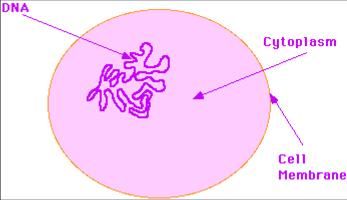Cards In This Set
| Front | Back |
|
What is the cell theory?
|
-In its modern form, the cell theory includes three principles:
-1. All organisms are composed of one or more cells
2. Cells are the smallest living things
3. Cells arise only by division of a previously existing cell
|
|
What are the two major kinds of cells?
|
-Prokaryotic Cells:
Only Bacteria Cells
Have no nucleus
-Eukaryotic Cells:
Fungi , plants , animals, protist
A nucleus is present
|
|
What are the cell types based on structure?
|
3 cell type based on structure:
1. Bacteria or Prokaryotic cell ( prokaryotes)
2. Animal cells ( eukaryotes)
3. Plant cells (eukaryotes)
|
|
What are the General Cell Features? (What all cells have)
|
 1. Cell membrane ( plasma membrane) 2. Cytoplasm 3. DNA |
|
Prokaryotic Cells
|
-Bacteria Cell
-Prokaryotes include bacteria and archaea
-Over 5,000 species are recognized
-Prokaryotes come in three main shapes:
---spiral
---rod
---spherical
|
|
Prokaryote cell sturucture
|
 -They lack a nucleus and organelles. |
|
List of Prokaryotic cell structures
|
Capsule
Cell Wall
Plasma membrane ( cell membrane)
Pilus
Flagella
DNA ( nucleoid region , bacteria chromosome)
Cytoplasm
Ribosomes
|
|
Prokaryotic Cell: Capsule
|
This is a protective layer around the bacteria. It is usually present in disease-causing bacteria.
|
|
Prokaryotic Cell: cell wall
|
There are two basic types of cell walls, Gram positive and Gram negative. The cell wall is a rigid layer that gives the bacteria protection and its shape.
|
|
Prokaryotic Cell: Plasma Membrane
|
This is a semi-permeable layer around cell
|
|
Prokaryotic Cell: DNA
|
This is where most of the bacteria's genetic information is stored.
|
|
Prokaryotic Cell: Cytoplasm
|
Liquid material inside the cell.
|
|
Prokaryotic Cell: Ribosome
|
Ribosomes are involved in making proteins.
|
|
Prokaryotic Cell: Pilus
|
Some bacteria have pili. Pili are used for adhesion to surfaces.
|
|
Prokaryotic Cells: Flagellum
|
Some bacteria have flagella so that they can move around in their environment.
|



